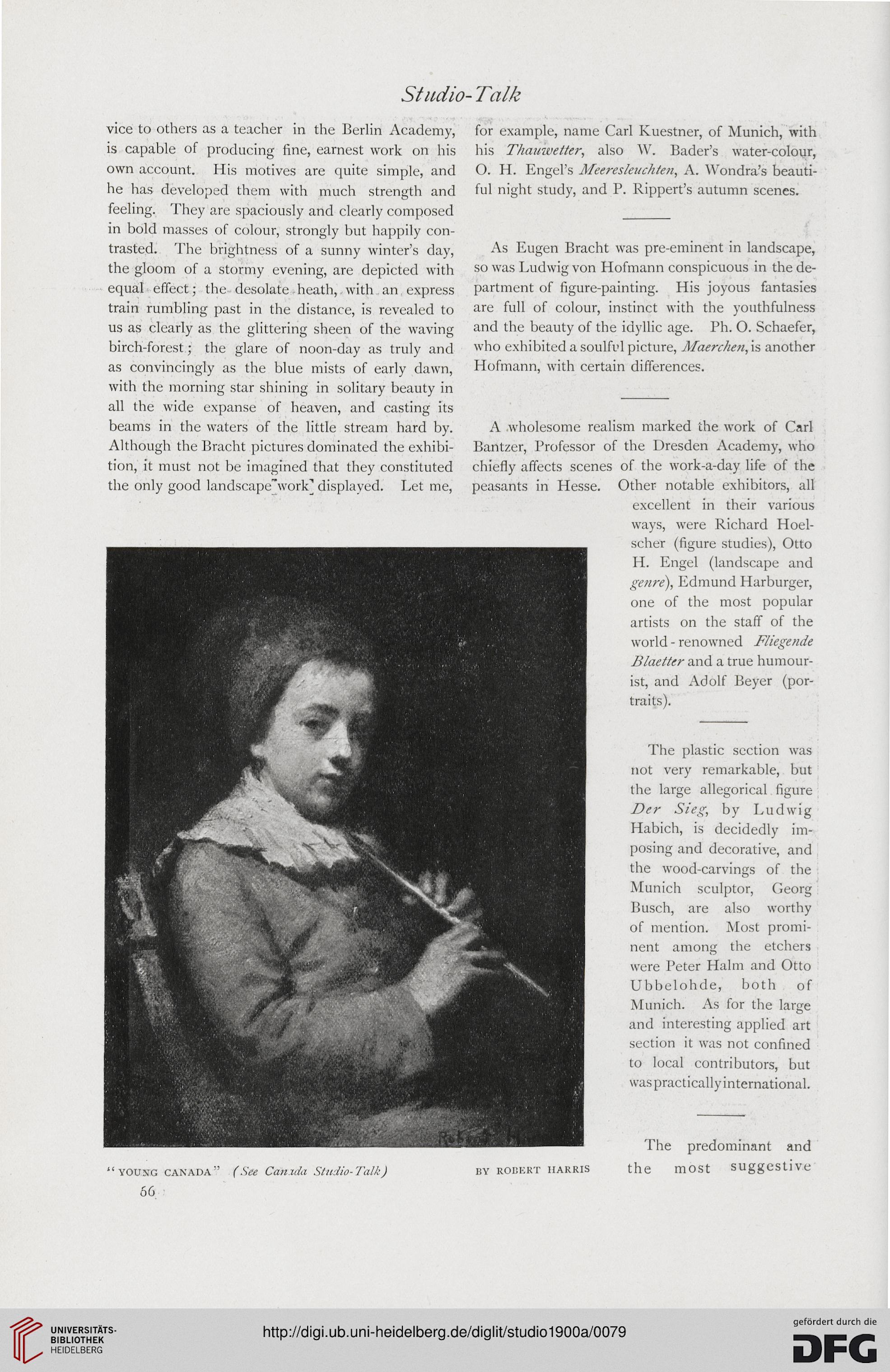Studio- Talk
vice to others as a teacher in the Berlin Academy, for example, name Carl Kuestner, of Munich, with
is capable of producing fine, earnest work on his his Thanwetter, also W. Bader's water-colour,
own account. His motives are quite simple, and O. H. Engel's Meeres/euchten, A. Wondra's beauti-
he has developed them with much strength and ful night study, and P. Rippert's autumn scenes.
feeling. They are spaciously and clearly composed _
in bold masses of colour, strongly but happily con-
trasted. The brightness of a sunny winter's day, As Eugen Bracht was pre-eminent in landscape,
the gloom of a stormy evening, are depicted with so was Ludwig von Hofmann conspicuous in the de-
equal effect; the desolate heath, with an express partment of figure-painting. His joyous fantasies
train rumbling past in the distance, is revealed to are full of colour, instinct with the youthfulness
us as clearly as the glittering sheen of the waving and the beauty of the idyllic age. Ph. O. Schaefer,
birch-forest; the glare of noon-day as truly and who exhibited a soulful picture, Maerchen,\s another
as convincingly as the blue mists of early dawn, Hofmann, with certain differences,
with the morning star shining in solitary beauty in
all the wide expanse of heaven, and casting its
beams in the waters of the little stream hard by. A wholesome realism marked the work of Carl
Although the Bracht pictures dominated the exhibi- Bantzer, Professor of the Dresden Academy, who
tion, it must not be imagined that they constituted chiefly affects scenes of the work-a-day life of the
the only good landscape"work' displayed. Let me, peasants in Hesse. Other notable exhibitors, all
excellent in their various
ways, were Richard Hoel-
scher (figure studies), Otto
H. Engel (landscape and
genre), Edmund Harburger,
one of the most popular
artists on the staff of the
world - renowned Fliegende
Blaetter and a true humour-
ist, and Adolf Beyer (por-
traits).
The plastic section was
not very remarkable, but
the large allegorical figure
Der Sieg, by Ludwig
Habich, is decidedly im-
posing and decorative, and
the wood-carvings of the
Munich sculptor, Georg
Busch, are also worthy
of mention. Most promi-
nent among the etchers
were Peter Halm and Otto
Ubbelohde, both of
Munich. As for the large
and interesting applied art
section it was not confined
to local contributors, but
was practically international.
The predominant and
: YOUNG CANADA" (See Cdnida Studio-Talk) BY ROBERT HARRIS the most suggestive
66
vice to others as a teacher in the Berlin Academy, for example, name Carl Kuestner, of Munich, with
is capable of producing fine, earnest work on his his Thanwetter, also W. Bader's water-colour,
own account. His motives are quite simple, and O. H. Engel's Meeres/euchten, A. Wondra's beauti-
he has developed them with much strength and ful night study, and P. Rippert's autumn scenes.
feeling. They are spaciously and clearly composed _
in bold masses of colour, strongly but happily con-
trasted. The brightness of a sunny winter's day, As Eugen Bracht was pre-eminent in landscape,
the gloom of a stormy evening, are depicted with so was Ludwig von Hofmann conspicuous in the de-
equal effect; the desolate heath, with an express partment of figure-painting. His joyous fantasies
train rumbling past in the distance, is revealed to are full of colour, instinct with the youthfulness
us as clearly as the glittering sheen of the waving and the beauty of the idyllic age. Ph. O. Schaefer,
birch-forest; the glare of noon-day as truly and who exhibited a soulful picture, Maerchen,\s another
as convincingly as the blue mists of early dawn, Hofmann, with certain differences,
with the morning star shining in solitary beauty in
all the wide expanse of heaven, and casting its
beams in the waters of the little stream hard by. A wholesome realism marked the work of Carl
Although the Bracht pictures dominated the exhibi- Bantzer, Professor of the Dresden Academy, who
tion, it must not be imagined that they constituted chiefly affects scenes of the work-a-day life of the
the only good landscape"work' displayed. Let me, peasants in Hesse. Other notable exhibitors, all
excellent in their various
ways, were Richard Hoel-
scher (figure studies), Otto
H. Engel (landscape and
genre), Edmund Harburger,
one of the most popular
artists on the staff of the
world - renowned Fliegende
Blaetter and a true humour-
ist, and Adolf Beyer (por-
traits).
The plastic section was
not very remarkable, but
the large allegorical figure
Der Sieg, by Ludwig
Habich, is decidedly im-
posing and decorative, and
the wood-carvings of the
Munich sculptor, Georg
Busch, are also worthy
of mention. Most promi-
nent among the etchers
were Peter Halm and Otto
Ubbelohde, both of
Munich. As for the large
and interesting applied art
section it was not confined
to local contributors, but
was practically international.
The predominant and
: YOUNG CANADA" (See Cdnida Studio-Talk) BY ROBERT HARRIS the most suggestive
66




